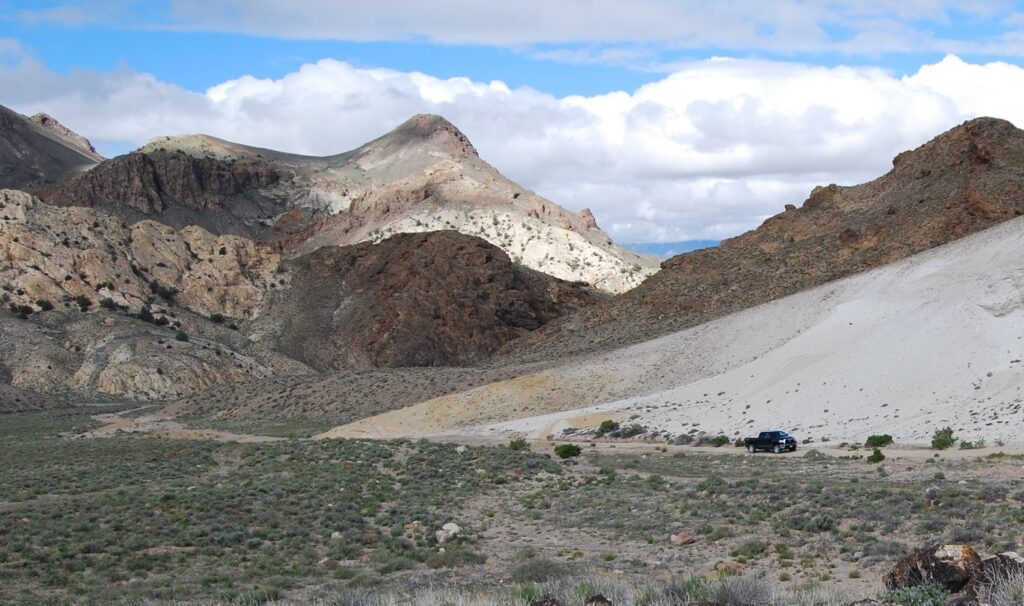
The “White Hill” at Rhyolite Ridge in Esmeralda County, Nevada. (Photo courtesy Ioneer)
The federal government is now facing a lawsuit challenging its approval of the first domestic lithium project authorized under the Biden Administration, which opponents say would threaten the survival of an endangered wildflower endemic to Nevada.
In October, the U.S. Bureau of Land Management issued the final approval for Ioneer’s Rhyolite Ridge Lithium-Boron mine in Esmeralda County after a four-year federal permitting and environmental review process.
Now a coalition of conservation groups are suing the U.S. Department of the Interior and affiliated agencies for allegedly violating several federal laws by approving the mine, including the National Environmental Policy Act, the Federal Lands Policy and Management Act, and the Endangered Species Act.
The lawsuit — filed by the Center for Biological Diversity, Western Shoshone Defense Project, and the Great Basin Resource Watch — claims the federal government failed to ensure the mine would not jeopardize the survival of the Tiehm’s buckwheat or adversely affect its critical habitat during the environmental review process.

Tiehm’s buckwheat, an endangered wildflower, grows on just 10 acres of lithium-boron rich soil near the Silver Peak Range in Esmeralda County.
If constructed, the mine would directly disturb about 191 acres of the wildflower’s federally protected critical habitat. The elimination of nearly 200 acres of habitat would cause habitat fragmentation, increase invasive species, and harm insects and other pollinators the wildflower relies on for survival, according to the lawsuit.
The mine’s quarry — a deep open pit where the lithium would be extracted — would also be developed up to 15 feet away from the nearest Tiehm’s buckwheat plant, which conservation groups say could expose the wildflowers to land subsidence, and geologic instability from mine-pit excavation.
“This lawsuit is about much more than just preventing the extinction of Tiehm’s buckwheat,” said Patrick Donnelly, Great Basin director at the Center for Biological Diversity in a statement. “The Bureau of Land Management’s authorization of the Rhyolite Ridge Mine is a flagrant violation of numerous environmental protection laws, and the integrity of these bedrock conservation laws is at stake. We need lithium for the crucial transition to renewable energy, but the government can’t break the law and drive species to extinction to get it.”
Australia-based Ioneer — the company behind the lithium mine — rejects the idea that the mine would jeopardize the survival of Tiehm’s buckwheat or adversely impact its critical habitat.
“We are confident that the BLM will prevail against this lawsuit. We intend to intervene and vigorously defend the BLM’s decision which was based on its careful and thorough permitting process. We do not expect this lawsuit to meaningfully affect our proposed development timeline,” said Chad Yeftich, vice president of corporate development and external affairs for Ioneer.
Once constructed, the massive 7,000 acre project would be in operation for 23 years and extract enough lithium from Nevada’s public lands to supply nearly an estimated 370,000 electric vehicles each year.
The mining company said they are currently developing a formal Tiehm’s buckwheat protection plan as part of their future mitigation efforts, and have made commitments to water conservation, as well as dust, noise and light monitoring.
Groundwater already over-appropriated, over-pumped
Conservation groups argued that Ioneer’s purported mitigation and monitoring plans were not included in the environmental review process, and thus were not subject to public and agency review as required under federal law.
The litigating conservation groups argued that the final environmental review of the mine didn’t include specific mitigation measures for water resources, which they believe could lead to an overall increase in groundwater use.
Lithium extraction requires massive amounts of water. According to the final environmental review, the mine will need about 4,035 acre-feet per year – enough water to supply nearly 11,000 homes.
Ioneer plans to source water from Esmeralda County’s Fish Lake Valley, where the groundwater supply is already over-appropriated and over-pumped.
While existing water rights holders, largely farmers, in Fish Lake Valley are authorized to pump a total of 51,004 acre-feet annually, only about 29,700 acre-feet of groundwater is pumped per year, based on the last five years of pumping records available at the Nevada Division of Water Resources. That level of pumping has already caused groundwater levels in Fish Lake Valley to decline by up to 200 feet over the last 50 years.
“The Rhyolite Ridge mine approval was reckless and a disaster waiting to happen. The full consequences of the proposed mine have not been determined,” said John Hadder, director of Great Basin Resource Watch. “Approval of this mine risks rolling back standards of protection and advancing an era of relaxed mine permitting that we and future generations will seriously regret.”
The Western Shoshone Defense Project — who are representing the Western Shoshone National Council in the lawsuit — said the mine’s water use could potentially dry out Cave Spring, a sacred site less than a mile from the proposed mine quarry.
According to the project’s final environmental review, if Cave Spring is fed by groundwater the mine could potentially decrease the amount of water discharged from the spring.
“Continuously extracting resources to maximize profit harms land and water, and we’ve witnessed plant and animal life disappear as the government mismanages the environment it’s supposed to protect,” said Fermina Stevens, director of the Western Shoshone Defense Project. “In the end, the Indigenous people of Nevada will suffer the consequences of irresponsible land management. One cannot save the planet from climate change while simultaneously destroying biodiversity.”

